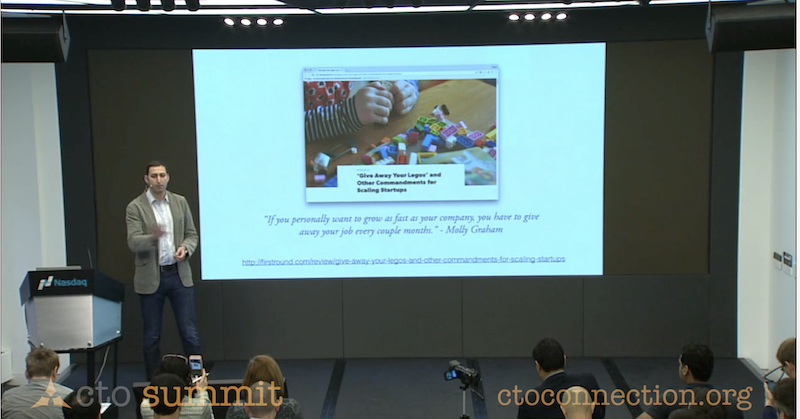Update: a recoreded talk based on this post at the CTO Summit @ Nasdaq.

CTO Summit @ Nasdaq - Inspiring Team Leads to Give Away Their Legos, 2016
Or keep reading …
A few months ago I asked myself: What does a CTO do?. I divided my attention across three priorities: people, technology and business, spent a lot of time with the entire team, beyond Engineering, created time to think, learned to connect people in a more systematic way and started actively extracting useful work patterns, sometimes even turning hindsight into foresight.
Let’s step up a notch.
How do you grow leads?
I spend a lot of time with managers digesting their problems with running a team and working through complex relationships between individuals. I generally focus on helping them identify what they do poorly and finding opportunities to improve. That helps them avoid making the same mistakes twice, but nobody ever walks out of such a conversation inspired to become truly great at anything.
The most useful piece of advice I can ever give to someone who wants to become great at their job is to work themselves out of it, better explained in Molly Graham’s Give Away Your Legos.
So, how do you inspire leads to give away their legos?
I recently learned a pattern of conversation from my executive coach. I may have reordered it a bit. The gist is to help the individual see that freeing up their time means achieving their mission, getting them closer to their vision and therefore having an impact on the entire company.
The key is to ask and not tell, to help people see the possibilities themselves. Begin with the following question.
What are you great at?
This is a very powerful opening. It completely changes the dynamic and does more than engage the other party in a lovely exercise of patting themselves on the back. It provides a summary of the best skills. For example, one may reply that they are really good at understanding customer needs and connecting with customers, and applying this skill to closing new deals.
Often people don’t even see what they are good at, because they take it for granted. To our sample conversation I would add that they are great at teaching others how to understand customers.
If you freed up some of your time, what would be possible for you?
This is a way of asking: If you had more free time, how would you apply your unique ability? Someone who excels at selling may reply that they could create a systematic and scalable approach to both selling and retaining the customer.
What would that mean for the company?
That would be big. A solid system around acquiring new customers and reducing churn could double the size of the business in 2016. A good sales person would be incredibly excited by this, but we must spell out a concrete growth path.
You’re an excellent sales person, but I see you as leading two teams, one that sells new deals and another that supports existing customers.
The only way this can happen is if the individual delegates each one of these two responsibilities.
This works in reverse as well when you want to take a lego away from your manager who stubbornly refuses to pass their “boring” tasks down by “protecting” you or your team. While they are missing the fact that such work may be very very exciting and new to you, they are primarily not seeing what would be possible for themselves.
To summarize, zoom out and find what the individual is great at, then zoom in, but ask, don’t tell.

